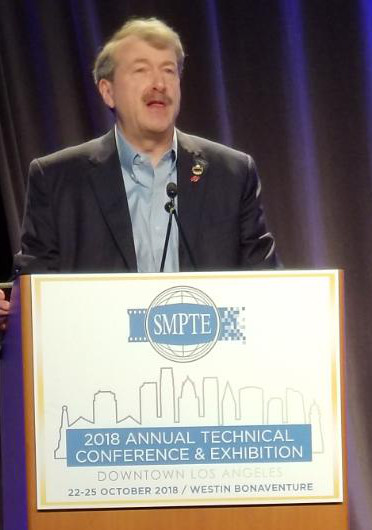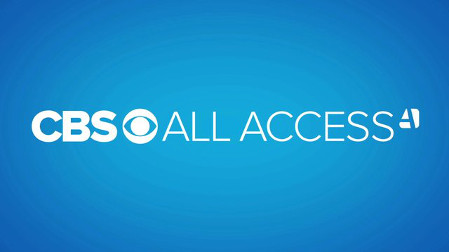LOS ANGELES—The story behind the tech strategy at the heart of CBS All Access is really a tale of playing to one’s strengths and circumventing one’s limitations to find success in the mobile and over-the-top world.
That was the main takeaway from an update on the four-year-old service delivered by Bob Seidel, CBS vice president of engineering and advanced technology at the SMPTE 2018 Annual Technical Conference and Exhibition.
OVERCOMING RESTRICTIONS
The network’s strengths are well-known: a powerful programming lineup, a deep content library of shows with some 10,000 episodes, a well-respected news organization, world-class sports coverage and a lineup of daytime programming and specials that is watched by millions. Add to that several popular new series, such as “Star Trek Discovery,” that are only available to CBS All Access subscribers.

However, delivering CBS content to mobile and over-the-top devices came with a set of restrictions that limited how the network could go about launching its service, said Seidel.
“The main problem and challenges broadcasters are faced with today delivering to mobile and over-the-top devices is that a license is granted by the network to affiliate stations to broadcast content to their DMA,” he said. “Therefore, we had to develop technology that would ‘geo-fence’ the signal to just the DMA they were authorized to distribute in.”
Another significant limitation was the record of failure broadcasters worldwide have experienced “independent of the technology or the modulation selected” when it comes to broadcasting a signal from their antennas to mobile devices, said Seidel.
The professional video industry's #1 source for news, trends and product and tech information. Sign up below.
The failures include TV Globo in Brazil with a COFDM service, Qualcomm MediaFlo and Dyle in the United States –the former using DVB-H and the latter using ATSC M/H—and others in Switzerland, Austria, Italy and Hungary, he said.
“These unsuccessful attempts led CBS to develop All Access,” he said. “We wanted to make sure we could deliver our linear broadcast content as well as library content to hundreds of millions of existing devices,” said Seidel, adding that the network wanted to do this on all wireless networks, including 3G, 4G, LTE, eventually 5G, and via 400,000 U.S. wireless hotspots.
[Read: CBS All Access Going Global]
There were other limitations as well, such as the “very high” capital costs associated with mobile TV for broadcasters and the aversion of cellular carriers to including mobile TV receivers in their handsets, he explained.
FOLLOWING THE VIEWER
Against this backdrop, CBS developed its mobile and OTT service with the goals of monetizing its content, enabling third-party audience measurement via Nielsen on all screens without leakage and providing a revenue share for its affiliates that contributed local news to the service geo-fenced by DMA.

CBS selected Syncbak as its All Access geo-fencing technology. Once Syncbak verifies the market in which a device is located it connects users to the CBS station in that market. If they should happen to be traveling, the connection will shift to the market All Access viewers have entered; however, an element of hysteresis is built in to prevent viewers driving between two cities from being switched away from a sporting event, he said.
CBS All Access begins in the master control of its affiliates and O&Os where Nielsen audio watermarking is added, which ultimately will allow the network and station to know exactly how many viewers are watching the service, said Seidel.
Next, a feed of the signal leaving master control is bridged off to the Syncbak transcoder, which converts MPEG-2 video to MPEG-4, AC-3 audio to AAC and the audio watermark to an ID3 tag –the packaging format used by iTunes to indicate song title, author and other information, he explained.
Rather than iTunes-related info, CBS inserts source identification, date, time and distributor codes. “We had to develop a method to deliver a sidecar data signal that would give us access to the Nielsen data,” he said.
Once past the station’s firewall, the transcoded stream is sent on to the Syncbak data center where geo-location is done, to match the correct station feed to the DMA where the user device is located. The data center can locate a phone or other device using GPS data, triangulation of cell towers or Wi-Fi hotspots, he added.
The authorized signal is then handed off to one of several content delivery networks for delivery to CBS All Access customers. The network uses load balancing software to make sure the best performing CDN is selected and to give subscribers the best possible viewing experience, said Seidel.
When the signal reaches the device, the CBS All Access application uses the Nielsen software development kit to access the ID3 tag and return the data to the ratings agency for accurate audience measurement.
Many service stacks defining video resolutions, MPEG-4 data rates and AAC data rates are available to match device type and size. For the hearing impaired, all closed captioning data is transcoded and made available on the service, he added.
AT THE LOCAL LEVEL
Equipping local stations for CBS All Access has been simple and straightforward. All that is required is a 1RU Syncbak device that takes in a station’s ASI signal and delivers back to the Syncbak data center IP packets. A second such unit is installed for redundancy, and two different delivery paths out of the station are in place to bypass any problem, such as a firewall issue or rebuffering, he said.
CBS, which monitors all 200 stations’ All Access service from New York City and Los Angeles, provides each station with its own signal from the CDN for monitoring, he added.
Beyond mobile devices, CBS All Access supports a wide range of OTT devices, such as Roku, Fire TV, Apple TV, Xbox 360 and PlayStation, said Seidel.
In the four years since its launch, CBS All Access has developed into a service that meets all of the network’s business needs. “It’s preserving the existing business requirements that we have for our local affiliates,” said Seidel. “It is providing a real-time live linear viewing capability across the board. It’s measured by Nielsen, so we are getting accreditation.”
CBS All Access is also helping the network, its owned stations and affiliates lower the average age of its viewers by reaching a younger audience on the devices they like to use, he added.
Following the presentation, one conference attendee asked Seidel whether CBS All Access might someday make use of some of the capabilities of ATSC 3.0. However, Seidel avoided mentioning the Next-Gen TV standard in his reply.
Phil Kurz is a contributing editor to TV Tech. He has written about TV and video technology for more than 30 years and served as editor of three leading industry magazines. He earned a Bachelor of Journalism and a Master’s Degree in Journalism from the University of Missouri-Columbia School of Journalism.

